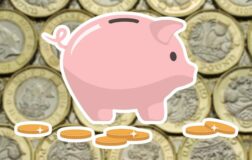What is an NFT?
The first NFT was created in 2014, but what exactly are they? Are they a scam? Can anyone buy one? And, above all, should you buy an NFT? Allow us to explain it all.
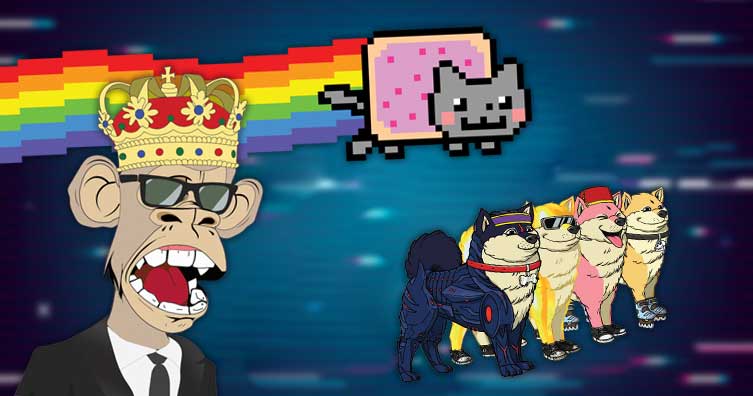
Credit: GGG999 (ape), Mininyx Doodle (cat and dogs), AdriaVidal (background) – Shutterstock
Disclaimer: This is an educational guide to help you understand NFTs – it is not investment or financial advice.
First, it was Bitcoin, now it's NFTs. The popularity of cryptocurrency and all related trends has been a bit of a rollercoaster over the last few years, but this latest craze seems to have people even more perplexed, angry and intrigued than any other.
We've taken a deep dive into NFTs to help you understand what they are, why they're considered valuable, what their risks are and how NFTs are traded.
What's in this NFT guide?
What are NFTs?
NFT is an abbreviation, short for non-fungible token. If you're wondering what on earth 'fungible' means, we don't blame you. Unless you're big into investing in the stock market, you may not have ever heard the word before.
Let's start by defining 'fungible'. If something is fungible, it means that, for all intents and purposes, one unit of it is identical (and of equal value) to another. Oil, gold and money are all examples of fungible items. For instance, two £5 notes are the same as one another, holding the same value and having the same use.
It's not just tradeable assets that are fungible. Lots of everyday items are fungible too, like bottles of milk in the fridge in the supermarket. Assuming they're all unopened, the same volume and the same type, each bottle is exactly the same. As a result, they all cost the same too.
So, if fungible things can be replicated and are of equal value, the opposite must be true of non-fungible things: no two versions of a non-fungible object can be the same, and their values differ accordingly.
Some common examples of non-fungible things include:
- Diamonds – No two diamonds will ever be exactly the same.
- Houses – Even in a row of seemingly identical terraced houses, the interiors may differ, and the fact that each house is on a different plot of land sets them apart from one another.
- People – Most people are distinguishable from one another, and even genetically identical twins will develop at least slightly different personalities.
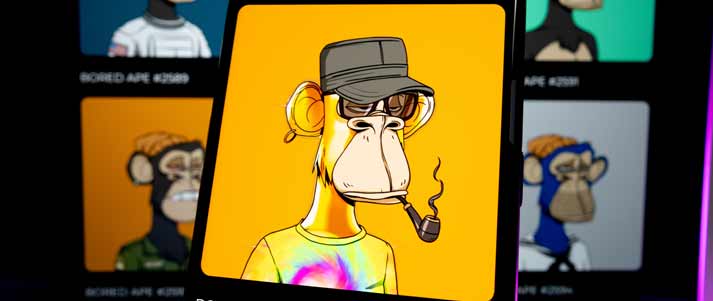
Credit: mundissima – Shutterstock
A non-fungible token is just another example of something that is unique, irreplaceable and interchangeable – except, crucially, NFTs are digital assets that can be bought or sold.
Most famously, NFTs take the form of digital art. You've probably seen a few examples online, like the Bored Ape Yacht Club collection (pictured above) or a gif of Nyan Cat. These are just two of the most well-known pieces, but there are thousands (if not millions) more collections and individual works of digital art up for sale as NFTs.
You may have also seen a series of NFTs being sold, where each image is visually identical to the next. You might think that this makes them fungible, as they all look the same. But, crucially, these visually identical NFTs will be given a unique number within the collection (e.g. #32 of 500).
The fact that there's only one of each number within the collection is what makes that piece non-fungible – at any given time, only one person can 'own' #32 of 500.
At this stage, you may be wondering just where the value is in this (a question we'll consider later), but the concept of limited editions isn't unique to NFTs. Plenty of real-world objects are intentionally produced in limited numbers (often with the specific issue number written on them), including cars, clothing, and physical art. In all of these cases, the object's apparent rarity increases its value.
However, while many people think NFTs are always digital art, the reality of the technology is far broader than that. All of the following (and more) have been bought and sold as NFTs:
- In-game assets, like character skins and weapons
- Music (in 2021, Kings of Leon sold an album as an NFT)
- A screenshot of the first-ever Tweet
- A column in the New York Times.
And in the future, when Mark Zuckerberg and co. envisage us living our lives in the metaverse, it's even been suggested that you'll be able to buy clothing that can only be worn digitally.
In short, as long as someone wants to buy it, anything that can be stored digitally can be sold as an NFT.
How do NFTs work?
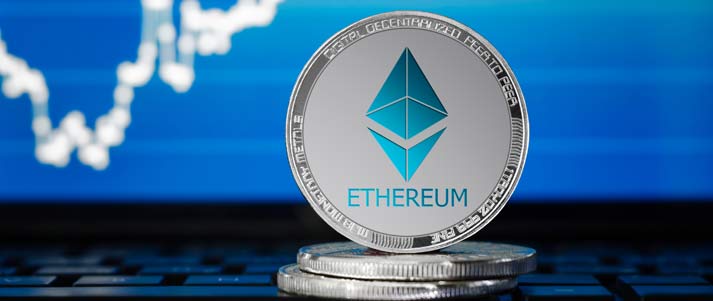
Credit: AlekseyIvanov – Shutterstock
The vast majority of NFTs are part of the Ethereum blockchain (and, in case you weren't already aware, Ethereum is a cryptocurrency, like Bitcoin). We say "the vast majority" as other cryptocurrencies can and do support their own versions of NFTs, and in the future, the market is likely to diversify. For now, Ethereum is the place to be.
As they form the basis of most cryptocurrencies, we've explained blockchains in more detail in our Bitcoin guide. But, put simply, a blockchain is a form of database that can be used to securely store and verify the authenticity of a data record.
The most important thing to understand about blockchain technology is that no single person or group can control the data and, due to the way it operates, anything that is entered into the blockchain is irreversible. And it's this intensely reliable, decentralised nature that makes blockchain technology a big part of why some people consider NFTs to be valuable.
Blockchain helps to answer one of the big questions people have about NFTs: how can you actually prove that you own one?
When you buy an NFT, blockchain technology allows you to have what essentially amounts to a certificate of authenticity, meaning that you know you own it. Other people can take a screenshot of an NFT but, unlike the person who bought it, they won't have any proof that they own the original version. Only the person who purchased the NFT has that.
As for the point of buying an NFT? Well, that leads us neatly on to the next big question...
Are NFTs valuable?
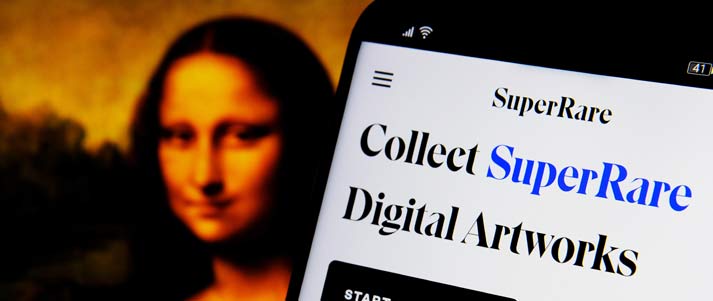
Credit: mundissima – Shutterstock
Part of the reason NFTs have become so well-known is that a small minority have sold for eye-watering sums. And, as with many new phenomena, people have questioned just what value there is in owning an NFT – particularly as, in the case of NFT art, a screenshot often looks exactly the same.
It's far from a perfect comparison (as we'll explain shortly), but it can help to think of NFT art in the same way as physical art. Let's take the Mona Lisa as an example.
There are countless replica prints of the Mona Lisa in existence. Go on sites like Etsy or Amazon and you'll find thousands on sale, with some going for as little as £3 or less. The quality can leave a lot to be desired but, as you might expect, the more you pay, the better they look.
Depending on the price, you could even end up with a replica print that – to most casual observers – looks identical to the original Mona Lisa. But, unlike the actual Mona Lisa, your replica won't be worth $870 million (one of the most recent estimates for the insured value of the painting).
The reason is that no matter how good your replica print is, it still isn't the Mona Lisa. And the same applies to NFT art: you can take a screenshot of one, but you can't say that it's yours unless you bought it and effectively own the receipt.
Many people have questioned and criticised the types of digital art being sold as NFTs. They often suggest that it's ludicrous for simple drawings, that don't seem to be intended to have meaning or artistic merit, to be selling for millions of pounds.
And they might be right. It's now said that around 95% of the NFTs created at the height of their popularity are now worthless.
Ultimately, a lot of factors are involved in the valuations of physical artworks and NFTs, but one key principle remains: part of the reason they can be considered valuable is that people decide that they are.
Utility NFTs and why the art comparison is imperfect
We should stress, we're well aware that the comparison between NFTs and physical art isn't a perfect one! The question of 'what makes art valuable?' is extremely complex with many factors involved – we've just used it as an example to help explain why people might place value on an NFT.
The complexity of the art market is one reason that makes the comparison between NFT art and physical art slightly flimsy, and another is that the purpose of a piece of NFT art can extend beyond the visual.
Utility NFTs are a growing trend whereby an NFT is no longer just a sequence of ones and zeroes – it's more like a membership or a key to gain access to lots of exclusive things. In the case of CryptoPunks (pictured below), widely considered to be the first NFT collection, owning one unlocks access to social networks and a free NFT from other collections.
And, when it comes to NFTs that aren't pieces of visual art, the physical art comparison is pretty redundant.
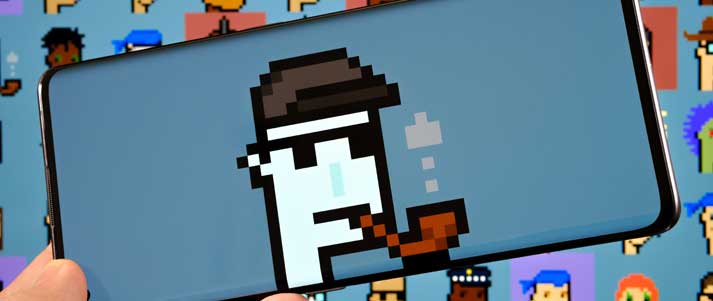
Credit: mundissima – Shutterstock
Take The Sandbox, for instance, where anyone (including major companies like Ubisoft and Gucci) can buy plots of 'land' and use it to create experiences, games and events, all accessible in the metaverse.
Here, the NFTs are the individual plots – at any given time, only one person can own the plot with the coordinates 136, -59 (to give just one example). For many people, it's easier to see the value of this kind of NFT, as opposed to a visual art NFT.
What's more, the fact that NFTs are usually either unique or part of a limited series means that they appeal to people's desire to own rare and collectable items.
Think about stamps or Pokémon cards. Despite there being no real use in owning them (particularly as part of a collection, when they'll likely be hidden away for safekeeping), people still hoard them, partly because some versions are extremely rare.
The idea of owning something that very few others can is very appealing, and hence people will pay huge sums for things that many of us wouldn't see any value in whatsoever (for instance, some Pokémon cards sell for over £230,000).
So, despite what you may think of NFTs, it's clear that the lure of exclusivity is something that increases value in a number of other markets too.
And, while the vast majority of NFTs sell for much more modest sums, the list of the most valuable NFTs shows that people really are willing to part with their cash for the prestige of knowing they own the one 'true copy' of a piece of digital art.
Most expensive NFTs ever sold
These are the most expensive NFTs ever sold:
- 'The Merge' by Pak ($91.8m)
- 'Everydays: the First 5000 Days' by Beeple ($69.3m)
- 'Clock' by Pak and Julian Assange ($52.7m)
- 'HUMAN ONE' by Beeple ($28.9m)
- 'CryptoPunk #5822' by Larva Labs ($23.7m).
List correct at the time of writing.
Should you buy an NFT?
Just because some NFTs have sold for millions of pounds, it doesn't mean that all will – in fact, some NFTs can be bought for just a few quid.
In October 2022, the average sale price of an NFT was about $120 (about £106) according to NonFungible.com. However, in January 2022, the average price sat at $3,250. Over the previous year, this figure had risen from $346 to $1,816 in a few weeks, then slowly down to $390 over a few months, before rising again towards the end of the year.
What this underlines is just how volatile the NFT market is. Just as we see with cryptocurrencies, including Bitcoin, the average NFT price can rise or fall wildly in a relatively short space of time. And while this means you could make a lot of money very quickly, you could just as easily lose a lot of money too.
Many people suspect the boom in NFT prices could be a bubble, which means that prices would eventually plummet. However, even if this were to happen, it wouldn't necessarily be a death sentence for NFTs – just look at Bitcoin.
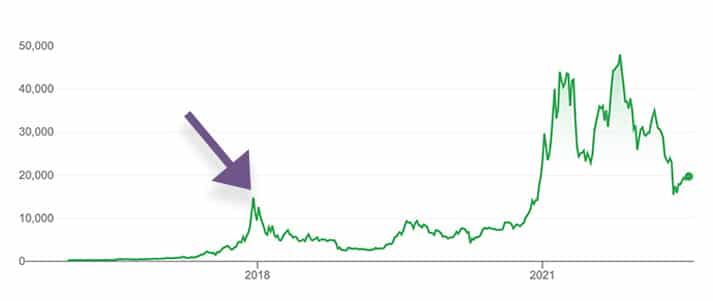
Credit: Google
The graph above shows the price of Bitcoin over time. We've added a big arrow to highlight a time towards the end of 2017, when the price of Bitcoin surged to a then-record high, before dropping sharply in 2018.
This was undoubtedly a case of a bubble growing and eventually bursting. But, as you can see, the price eventually recovered over the course of a few years. So much so, in fact, that even when the prices dropped in 2021 and 2022, Bitcoin's lowest price still exceeded its 2017 peak.
It's important to emphasise that there's no guarantee that the average NFT price will follow the same trajectory as Bitcoin's – it could just as easily crash and never recover. Bitcoin's value is also very much the exception rather than the rule when it comes to cryptocurrencies, with the next most popular currency (Ethereum) only worth around 4% as much.
And to get an idea of just how unpredictable the future of NFTs is, it's worth remembering that even Bitcoin, which is relatively established by comparison, still sees huge price fluctuations.
You should also be wary that you're very unlikely to buy an NFT for a small amount and later sell for the kinds of prices you've seen in the headlines.
The most expensive NFTs have sold for these amounts because of the hype around them and their respective artists. Never say never but, by contrast, selling #56 of 221 of Luke Shaw's Digital Signature collection will probably never make you a millionaire.
And, above all, don't get sucked into buying an NFT because of FOMO. While it may be a driving force behind the market getting involved with this trend, FOMO is not a good reason to invest (and risk!) your hard-earned cash.
How to buy NFTs
Here's how to buy an NFT:
-
Open a crypto wallet
Although the media usually publicises NFT sale prices in dollars, the truth is that you can only buy an NFT using cryptocurrency. And to do this, you'll need to have a crypto wallet.
As we mentioned earlier, most NFTs operate on the Ethereum blockchain. This means you'll need some Ethereum (ETH) to buy one and, in turn, a crypto wallet that supports this particular currency.
Fortunately, as one of the most common cryptocurrencies, it isn't hard to find wallets that support ETH. Both eToro and Coinbase do.
However, please note that keeping your cryptocurrencies (or NFTs) in a wallet provided by a marketplace (like eToro or Coinbase) is different to keeping them in the marketplace itself. In short, if you keep your assets in the marketplace and the marketplace is hacked, your assets aren't safe, so it's always best to keep them in a wallet if possible.
There are also non-marketplace providers of crypto wallets, like MetaMask, to which you can send your Ethereum once you've bought some (check out MetaMask's website for guidance on this).
You can also buy hardware wallet keys if you want to get really serious about things.
-
Buy some Ethereum

Credit: David Pereiras – Shutterstock
Once you've opened a crypto wallet, the next step is to buy some Ethereum.
Our guide to buying Bitcoin explains a very similar process but, to be perfectly honest, once you've set up your crypto wallet, most of the hard work is done. Whether you're using eToro, Coinbase or any other trading platform, it should be pretty clear how to buy some ETH, with plenty of guides to help you.
The only point to consider is whether or not you're getting the best value for money. We won't go into too much detail here but, as we outline in our guide to how the stock market works, deciding when to invest in something (whether that's stocks, a cryptocurrency, an NFT or anything else) could determine how much bang you get for your buck.
Time it right, and you could end up with far more ETH in your crypto wallet than if you'd invested the exact same amount of money at a different point. Time it wrong, and you could end up with much less.
Either way, if you're using a crypto wallet not connected to a marketplace (like MetaMask), you'll then need to transfer your ETH to your wallet. Again, if you're unsure how to do this, the website of your crypto wallet of choice should have a guide.
-
Choose an NFT marketplace
There are loads of NFT marketplaces out there, most of which sell a range of assets like digital art, music, collectables, in-game items and more.
Each marketplace will have different collections on sale, so if there's a particular NFT that you'd like to buy, it might be worth working backwards (i.e. signing up for the marketplace that sells it, rather than selecting a marketplace and then choosing an NFT you like).
Best NFT marketplaces
Here's where you can buy NFTs:
-
Link your crypto wallet to the NFT marketplace
This step is relatively simple, but absolutely essential to the process. As well as needing a crypto wallet to hold the ETH required to purchase most NFTs, you'll also need a crypto wallet to store the NFT itself.
Fortunately, linking your crypto wallet to your NFT marketplace is easy. Precisely how to do it will vary depending on the site and wallet you choose, but each one should have a guide to help you if you get stuck.
-
Browse the available NFTs
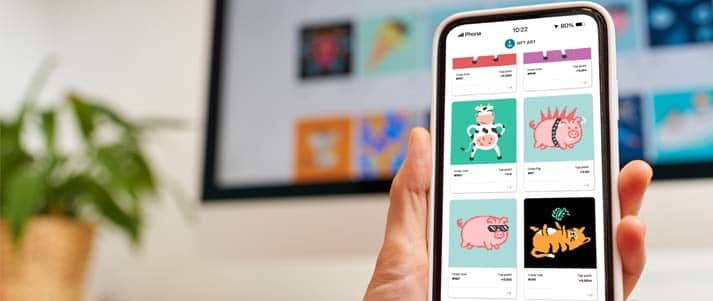
Credit: David Pereiras – Shutterstock
As we touched on earlier, if you have your eyes on a particular NFT, it might be worth doing this step before signing up to a marketplace. But, if not, now's your chance to browse the likely thousands of NFTs available to buy.
Don't rush your decision, either – you might be using digital currency to buy digital assets, but it's real money underpinning it all.
-
Buy an NFT
Once you've found an NFT you'd like to buy, the next step is... well, buying it.
A little bit like buying stuff on eBay, some NFTs will be listed under auction and others will be available to buy instantly. But if the NFT you're interested in can only be bought through an auction, try not to get sucked into a bidding war.
For all the reasons we listed above, in particular the fact that NFTs are a relatively new phenomenon and could well be a short-lived bubble, you need to be comfortable with the possibility of never being able to sell your purchase for a profit.
If you've submitted the highest bid by the time the auction ends (or you've made an instant purchase), you'll now be the owner of an NFT. The marketplace should do the rest of the work in terms of placing your newly acquired asset in your crypto wallet.
-
Wait for your NFT to arrive in your wallet
Assuming that you and the seller both have your crypto wallets connected to the marketplace, the NFT should be transferred from their address to yours automatically. It may take a little while for it to appear in your wallet – up to an hour, in some cases – but it should land eventually!
All NFT transfers are stored and publicly viewable online in the blockchain, and you can see them for yourself on websites like Etherscan.
Each transaction shows a whole load of information, including who is sending and receiving the NFT in question. In some cases, you'll even be able to view the NFT that was bought – click "View NFT" on any of these WhiteRabbitOne transactions and have a nosey.
As for viewing any NFTs that you buy, this should be possible via your NFT wallet. If you're having trouble figuring out how to do this, check out your crypto wallet's help section.
NFT FAQs
What is the environmental impact of NFTs?
Like Bitcoin, NFTs have a surprisingly large environmental impact.
While blockchain technology makes cryptocurrencies and NFTs incredibly secure and reliable, the trade-off is that it needs an immense amount of computing power in order to operate.
Much of this is conducted by supercomputers in China, many of which are still powered by fossil fuels – and where there are fossil fuels, there are carbon emissions. Some estimates suggest that Bitcoin's carbon emissions alone could increase global temperatures by 2°C, and while there aren't many equivalent stats for NFTs, it's certainly a wake-up call to the impact of these digital assets.
There is some cause for hope, though. In September 2022, in an update known as "the merge", Ethereum completed a switch to a much more energy-efficient system.
Experts claim it could reduce the power consumption of the Ethereum network by as much as 99.95%, massively reducing its carbon footprint in the process. And this is all without losing the security and reliability that makes the Ethereum blockchain so appealing.
That said, not all NFTs are hosted on Ethereum, and even then the carbon footprint isn't nil. So if you're concerned about climate change, you may want to avoid buying an NFT altogether – or, at the very least, reduce your carbon footprint to offset the impact.
Are NFTs a scam?
The legitimacy of NFTs totally depends on who you ask.
NFT loyalists will say they're the future – liberating small, independent artists and opening up new frontiers for the development and ownership of digital assets.
On the other hand, critics will argue that the idea of 'owning' an NFT is both flimsy and meaningless, with some even going as far as labelling it a Ponzi scheme. This is a type of investment fraud whereby early adopters (in this case, the first groups of people to buy or make NFTs) make a profit at the expense of those who invest later on.
Others have suggested that NFTs are largely being used to help people avoid tax and launder money. Again, the jury is still out on this one – while it would be naive to assume that nobody is using NFTs for this purpose, there's not enough evidence to indicate the scale at which it may be taking place.
On balance, it's fair to say that the technology behind NFTs is not a scam in and of itself. But it could be claimed that certain sections of the NFT world are a little less than honest – for example, specific collections being hyped to increase their value to astronomical amounts.
Can you make your own NFT?
In theory, anybody can create and sell their own NFT.
If you're a digital artist and you're looking for a new way to sell your art, NFTs could be worth investigating. In fact, as we outlined earlier, NFTs can be any kind of digital asset, so creating and selling one isn't just limited to those with an artistic flair.
That said, if you are keen to get involved with visual art NFTs specifically, you could always consider paying someone to make one for you. Head to Fiverr, for example, and there are loads of creators who you can hire to do the hard work.
But remember that if your goal is to make money from NFTs, you'll need to be confident that whatever you're paying this person is less than what you expect to make from selling your NFT.
And bear in mind that you'll also need someone to buy your NFT. So, despite what you may think of some of the pieces being sold, it's a little risky to just put any old rubbish out there and hope it sells.
What's more, given the carbon footprint of NFTs, there are probably far less environmentally damaging ways to sell your work instead.
If you're looking for more traditional ways to make your money work for you, check out this list of ways to invest.

